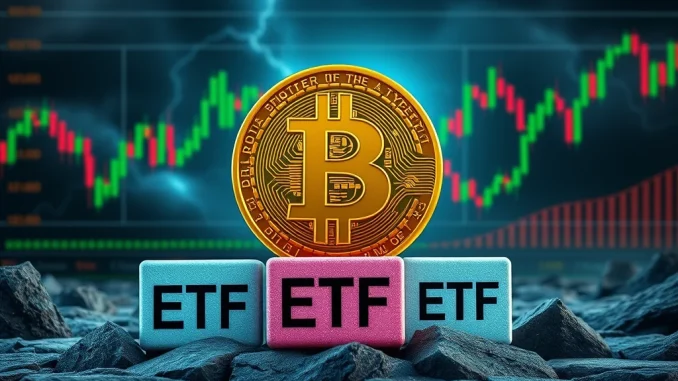
In a world of wild crypto swings, one might expect Bitcoin’s price to be as unpredictable as ever, especially with global economic uncertainties looming. But hold on – a recent report from BeInCrypto suggests a surprising twist: Bitcoin exchange-traded funds (ETFs) are stepping in as unlikely heroes, injecting a dose of stability into the often-volatile Bitcoin market. Let’s dive deep into how these financial instruments are quietly reshaping Bitcoin’s price action and what it means for you.
Bitcoin ETFs: The Unsung Heroes of Price Stability
While headlines are often dominated by price pumps and dumps, the real story might be unfolding behind the scenes with Bitcoin ETFs. According to BeInCrypto’s analysis, these ETFs are acting as a crucial stabilizing force. Even as external factors like U.S. President Donald Trump’s tariff war inject uncertainty into the broader market, Bitcoin’s price has shown remarkable resilience. Why? The report points to ETF issuers playing the role of “whales,” strategically buying up Bitcoin when retail investors sell off in moments of panic or profit-taking.
Think of it like this: when the market gets choppy and some investors decide to exit their Bitcoin positions, these ETF issuers are there to absorb the selling pressure. This continuous buying activity creates a demand floor, preventing dramatic price drops and fostering price stability. It’s a fascinating dynamic, suggesting a maturing market where institutional involvement can buffer against traditional volatility.
Decoding ETF Inflows: A Deep Dive into IBIT’s Success
To truly understand the impact of ETF inflows, let’s look at the numbers. Eric Balchunas, a respected Bloomberg ETF analyst, highlights a key trend: Bitcoin ETFs have consistently recorded net inflows, both in the recent month and year-to-date. This means more money is flowing into these ETFs than out, indicating sustained investor interest and confidence.
One standout performer is BlackRock’s IBIT. This particular ETF has witnessed impressive net inflows of $2.4 billion so far this year. That’s a significant amount of capital pouring into Bitcoin indirectly through this ETF. These inflows are not just numbers on a screen; they represent real demand for Bitcoin exposure through a regulated and accessible investment vehicle. The consistent positive inflows into ETFs like IBIT are a strong indicator of institutional and potentially broader market belief in Bitcoin’s long-term value proposition, contributing significantly to price stability.
Why Institutional Whales Matter: ETF Issuers and Market Dynamics
The concept of ETF issuers acting as “whales” is crucial to grasp. In the cryptocurrency market, “whales” are entities with substantial holdings that can influence Bitcoin price movements. Traditionally, these could be early adopters or large private investors. However, with the advent of Bitcoin ETFs, a new type of whale has emerged: the ETF issuer.
These issuers manage billions of dollars and are mandated to hold actual Bitcoin to back the ETF shares they issue. When there are net inflows into an ETF, like IBIT, the issuer must purchase more Bitcoin to match the increased demand. Conversely, if there are outflows, they might need to sell Bitcoin. However, the current trend of consistent net inflows means these issuers are primarily buyers, providing continuous upward pressure or at least a strong support level for Bitcoin price.
This institutional involvement is a game-changer. It brings a level of maturity and stability to a market once characterized by extreme volatility. These aren’t just speculative retail trades; these are strategic allocations from large financial institutions, often with a longer-term investment horizon.
Navigating Market Turmoil: Bitcoin Price Resilience in the Face of Uncertainty
Consider the current global economic landscape. Trade tensions, inflationary pressures, and geopolitical events all contribute to market uncertainty. Historically, such uncertainty could send investors fleeing from riskier assets like Bitcoin, leading to sharp price declines. However, this time around, Bitcoin price action has been relatively subdued, even stable, despite these headwinds.
This resilience can be attributed, in part, to the stabilizing influence of Bitcoin ETFs. While retail sentiment might still be swayed by news headlines and short-term fluctuations, the consistent buying activity from ETF issuers provides a counterbalancing force. It suggests that a segment of the market, driven by institutional investors accessing Bitcoin through ETFs, is taking a longer-term view and is less reactive to short-term market noise. This dynamic is contributing to a more mature and less volatile Bitcoin price environment.
The Future of Bitcoin Pricing: Will ETFs Continue to Anchor Stability?
Looking ahead, the question is: will Bitcoin ETFs continue to play this anchoring role in Bitcoin pricing? While the future is never guaranteed, several factors suggest this trend could persist.
- Growing Institutional Adoption: As more institutional investors become comfortable with Bitcoin as an asset class, they are likely to increase their allocations through ETFs. This will lead to continued inflows and sustained buying pressure.
- Increased Regulatory Clarity: As regulatory frameworks around cryptocurrencies and ETFs become clearer, it could further legitimize Bitcoin ETFs and attract even more mainstream investment.
- Maturing Market Infrastructure: The cryptocurrency market infrastructure is maturing rapidly, with improved custody solutions, trading platforms, and risk management tools. This makes it easier and safer for institutions to participate, further supporting the role of ETFs.
However, it’s also crucial to acknowledge potential challenges. Significant outflows from ETFs could, in theory, create downward pressure. Regulatory changes or unforeseen market events could also impact the dynamics. Nevertheless, the current trajectory points towards Bitcoin ETFs becoming an increasingly important factor in shaping and stabilizing Bitcoin pricing.
Conclusion: A New Era of Bitcoin Stability?
The narrative of Bitcoin as a purely speculative and wildly volatile asset may be evolving. The emergence and growing influence of Bitcoin ETFs suggest a potential shift towards greater price stability. While volatility will likely always be a part of the crypto landscape, the strategic buying power of ETF issuers, driven by consistent inflows, appears to be introducing a new layer of resilience to the Bitcoin market. As institutional adoption continues to grow and ETFs become more deeply integrated into the financial ecosystem, we may be witnessing the dawn of a surprisingly more stable era for Bitcoin.



